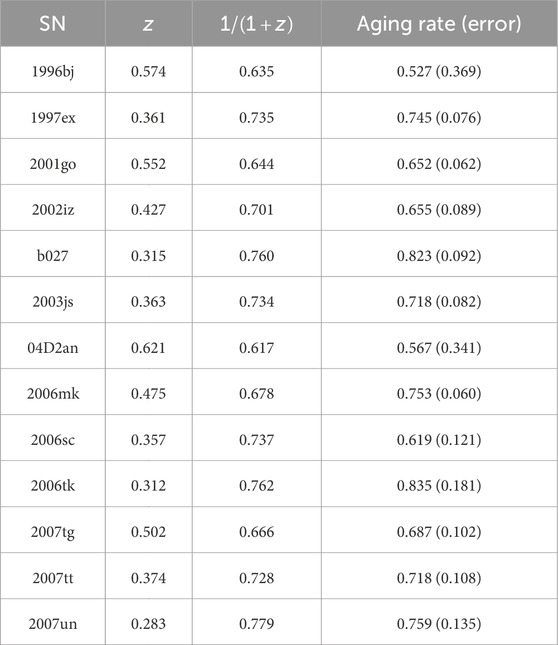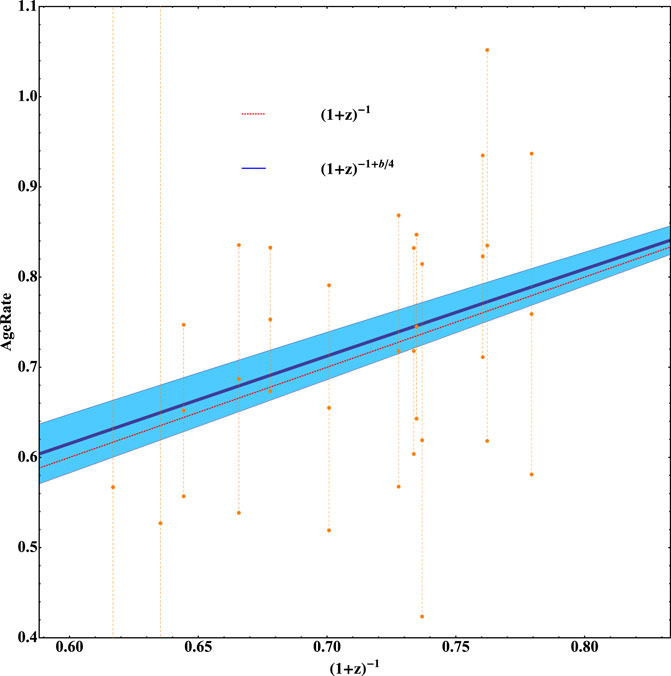- Department of Physics, Institute of Basic Science, Sungkyunkwan University, Suwon, Republic of Korea
The Robertson–Walker (RW) metric, derived from the cosmological principle and Weyl’s postulate, characterizes the
1 Introduction
The contemporary
The traditional RW metric can derive a specific relationship regarding cosmological time dilation (TD) based on the postulate of a constant speed of light. However, it is not directly derived from the metric’s fundamental principles. Various projects using supernova light curves (Leibundgut et al., 1996; Riess et al., 1997; Foley et al., 2005; Blondin and Tonry, 2007; Blondin et al., 2008; White et al.), gamma-ray bursts (Band, 1994; Norris et al., 1994; Wijers and Paczynski, 1994; Meszaros and Meszaros, 1996; Lee and Petrosian, 1997; Chang, 2001; Crawford; Zhang et al., 2013; Singh and Desai, 2022), and quasars (Hawkins, 2001; Dai et al., 2012; Lewis and Brewer, 2023) have attempted to measure cosmological TD, but conflicting results have prevented convincing detection. The speed of light in the RW metric might change with cosmic time without clear rules determining TD, just like other physical parameters like temperature and mass density. This variation supports the hypothesis of a varying speed of light (VSL) (Lee, 2021; Lee, 2023a; Lee, 2023b; Lee, 2024). In the RW universe, a hypersurface of specific time defines uniform physical quantities such as temperature or density, and these quantities are cosmologically redshifted due to the universe’s expansion.
One can rewrite the RW metric with the possibility of the VSL as follows:
Physical quantities like the scale factor
where SMC stands for the standard model cosmology and
2 Methods
In an expanding universe described by the RW metric, galaxies uniformly recede from each other, and TD affects clocks differently depending on the distance. Whether the speed of light is constant or not influences local clock rates, thus playing a crucial role in understanding TD. Therefore, it is important to obtain the precise relationship of TD by comparing observational data such as distant Type Ia supernovae (SNeIa) light curves and spectral evolution.
Supernova light curves (LCs) track brightness changes over time, crucial for understanding their evolution and properties, especially for SNeIa used as cosmological standard candles. Comparing LCs across different distances reveals TD effects due to cosmic expansion, indicating the stretching of distant LCs compared to nearby LCs. The spectral evolution of SNeIa provides a reliable method to measure aging and confirm TD, offering insights into the Universe’s expansion rate and dark energy dynamics.
We present aging rate measurements of 13 high-redshift SNeIa data provided in Blondin et al. (2008), as shown in Table 1. These data are derived from a sample of 35 spectra of 13 SNeIa in the redshift range

Table 1. Aging rate measurements from SNeIa observation (Blondin et al., 2008).
We perform a least-square fit to the data using the SMC and meVSL model predictions. The fitting is given by
where
3 Results
The aging rate analysis based on the SMC, using

Table 2. A simple

Figure 1. Time dilation for two models with data points. The dashed line depicts the SC prediction of TD. The thick solid line represents the best-fit value predicted TD of the meVSL model. The shaded region represents the 1-
4 Discussion
We derived the time dilation formula in the minimally extended varying speed of light model as
Author contributions
SL: conceptualization, data curation, formal analysis, funding acquisition, investigation, methodology, project administration, resources, validation, visualization, writing–original draft, and writing–review and editing.
Funding
The author(s) declare that financial support was received for the research, authorship, and/or publication of this article. This research was funded by the National Research Foundation of Korea (NRF), funded both by the Ministry of Science, ICT, and Future Planning (grant no. NRF-2019R1A6A1A10073079) and the Ministry of Education (grant no. NRF-RS202300243411).
Acknowledgments
The author is grateful for the invitation to present at the ‘Frontiers in Astronomy and Space Sciences: A Decade of Discovery and Advancement, 10th Anniversary Conference’. Additionally, the author would like to express his gratitude to the editor, who requested a mini-review related to this presentation.
Conflict of interest
The author declares that the research was conducted in the absence of any commercial or financial relationships that could be construed as a potential conflict of interest.
Publisher’s note
All claims expressed in this article are solely those of the authors and do not necessarily represent those of their affiliated organizations, or those of the publisher, the editors, and the reviewers. Any product that may be evaluated in this article, or claim that may be made by its manufacturer, is not guaranteed or endorsed by the publisher.
References
Aghanim, N., Akrami, Y., Arroja, F., Ashdown, M., Aumont, J., Baccigalupi, C., et al. (2020). Planck2018 results: I. Overview and the cosmological legacy ofPlanck. Astron. Astrophys. 641, A1. arXiv:1807.06205 [astro-ph.CO]]. doi:10.1051/0004-6361/201833880
Benedetto, E., D’Errico, L., and Feoli, A. (2024). An evolution of the universe based on a modified time-redshift relation can avoid the introduction of a cosmological constant. Astrophys. Space Sci. 369 (4), 37. doi:10.1007/s10509-024-04301-x
Blondin, S., Davis, T. M., Krisciunas, K., Schmidt, B. P., Sollerman, J., Wood-Vasey, W. M., et al. (2008). Time dilation in Type Ia supernova spectra at high redshift. Astrophys. J. 682, 724–736. [astro-ph]]. doi:10.1086/589568
Blondin, S., and Tonry, J. L. (2007). Determining the Type, redshift, and age of a supernova spectrum. Astrophys. J. 666, 1024–1047. arXiv:0709.4488 [astro-ph]. doi:10.1086/520494
Brout, D., Scolnic, D., Popovic, B., Riess, A. G., Zuntz, J., Kessler, R., et al. (2022). The Pantheon+ analysis: cosmological constraints. Astrophys. J. 938 (2), 110. arXiv:2202.04077 [astro-ph.CO]]. doi:10.3847/1538-4357/ac8e04
Cawthon, R., Elvin-Poole, J., Porredon, A., Crocce, M., Giannini, G., Gatti, M., et al. (2022). Dark Energy Survey Year 3 results: calibration of lens sample redshift distributions using clustering redshifts with BOSS/eBOSS. Mon. Not. Roy. Astron. Soc. 513, 5517–5539. [astro-ph.CO]. doi:10.1093/mnras/stac1160
Chang, H. Y. (2001). Fourier analysis of gamma-ray burst light curves: searching for a direct signature of cosmological time dilation. Astrophys. J. Lett. 557, L85–L88. [astro-ph]. doi:10.1086/323331
Dai, D. C., Starkman, G. D., Stojkovic, B., Stojkovic, D., and Weltman, A. (2012). Using quasars as standard clocks for measuring cosmological redshift. Phys. Rev. Lett. 108, 231302. arXiv:1204.5191 [astro-ph.CO]]. doi:10.1103/PhysRevLett.108.231302
Foley, R. J., Filippenko, A. V., Leonard, D. C., Riess, A. G., Nugent, P., and Perlmutter, S. (2005). A definitive measurement of time dilation in the spectral evolution of the moderate-redshift Type Ia supernova 1997ex. Astrophys. J. Lett. 626, L11–L14. [astro-ph]. doi:10.1086/431241
Guzzo, L., Bel, J., Bianchi, D., Carbone, C., Granett, B. R., Hawken, A. J., et al. doi:10.1007/978-3-030-01629-6_1[arXiv:1803.10814 [astro-ph.CO]]
Hawkins, M. R. S. (2001). Time dilation and quasar variability. Astrophys. J. Lett. 553, L97–L100. [astro-ph]. doi:10.1086/320683
Hinshaw, G., Larson, D., Komatsu, E., Spergel, D. N., Bennett, C. L., Dunkley, J., et al. (2013). Astrophys. J. Suppl. Ser. 208, 20. arXiv:1212.5226 [astro-ph.CO]]. doi:10.1088/0067-0049/208/2/19
Lee, S. (2021). JCAP 08. J. Cosmol. Astropart. Phys. 2021, 054. arXiv:2011.09274 [astro-ph.CO]]. doi:10.1088/1475-7516/2021/08/054
Lee, S. (2023a). The cosmological evolution condition of the Planck constant in the varying speed of light models through adiabatic expansion. Phys. Dark Univ. 42, 101286. arXiv:2212.03728 [astro-ph.CO]]. doi:10.1016/j.dark.2023.101286
Lee, S. (2023b). A viable varying speed of light model in the RW metric. Phys. 53, 40. arXiv:2303.13772 [physics.gen-ph]]. doi:10.1007/s10701-023-00682-1
Lee, S. (2023c). Constraining minimally extended varying speed of light by cosmological chronometers. Mon. Not. Roy. Astron. Soc. 522 (3), 3248–3255. arXiv:2301.06947 [astro-ph.CO]]. doi:10.1093/mnras/stad1190
Lee, S. (2024). Review on minimally extended varying speed of light model. Particles 7, 309–326. arXiv:2406.02556 [physics.gen-ph]]. doi:10.3390/particles7020019
Lee, T. T., and Petrosian, V. (1997). Time dilation of BATSE gamma-ray bursts. Astrophys. J. 474, 37–46. [astro-ph]. doi:10.1086/303458
Leibundgut, B., Schommer, R., Phillips, M., Riess, A., Schmidt, B., Spyromilio, J., et al. (1996). Time dilation in the light curve of the distant Type Ia supernova SN 1995K. Astrophys. J. Lett. 466, L21–L24. [astro-ph]. doi:10.1086/310164
Lewis, G. F., and Brewer, B. J. (2023). Detection of the cosmological time dilation of high-redshift quasars. Nat. Astron 7 (10), 1265–1269. arXiv:2306.04053 [astro-ph.CO]]. doi:10.1038/s41550-023-02029-2
Meszaros, A., and Meszaros, P. (1996). Cosmological evolution and luminosity function effects on number counts, redshift, and time dilation of bursting sources. Astrophys. J. 466, 29. [astro-ph]. doi:10.1086/177491
Norris, J. P., Nemiroff, R. J., Scargle, J. D., Kouveliotou, C., Fishman, G. J., Meegan, C. A., et al. (1994). Detection of signature consistent with cosmological time dilation in gamma-ray bursts. Astrophys. J. 424, 540. [astro-ph]]. doi:10.1086/173912
Riess, A. G., Filippenko, A. V., Leonard, D. C., Schmidt, B. P., Suntzeff, N., Phillips, M. M., et al. (1997). Time dilation from spectral feature age measurements of Type IA supernovae. Astron. J. 114, 722. [astro-ph]. doi:10.1086/118506
Singh, A., and Desai, S. (2022). JCAP 02. J. Cosmol. Astropart. Phys. 2022 (02), 010. arXiv:2108.00395 [astro-ph.HE]]. doi:10.1088/1475-7516/2022/02/010
White, R. M. T., Davis, T. M., Lewis, G. F., Lidman, C., Shah, P., Abbott, T. M. C., et al. [DES]. [arXiv:2406.05050 [astro-ph.CO]].
Wijers, R. A. M. J., and Paczynski, B. (1994). On the nature of gamma-ray burst time dilations. Astrophys. J. Lett. 437, L107. [astro-ph]. doi:10.1086/187694
Keywords: varying speed of light, cosmological time dilation, supernovae, cosmological redshift, standard model cosmology
Citation: Lee S (2024) Constraining the minimally extended varying speed of light model using time dilations. Front. Astron. Space Sci. 11:1453806. doi: 10.3389/fspas.2024.1453806
Received: 24 June 2024; Accepted: 09 July 2024;
Published: 02 August 2024.
Edited by:
Julio Navarro, University of Victoria, CanadaReviewed by:
Elmo Benedetto, University of Salerno, ItalyCopyright © 2024 Lee. This is an open-access article distributed under the terms of the Creative Commons Attribution License (CC BY). The use, distribution or reproduction in other forums is permitted, provided the original author(s) and the copyright owner(s) are credited and that the original publication in this journal is cited, in accordance with accepted academic practice. No use, distribution or reproduction is permitted which does not comply with these terms.
*Correspondence: Seokcheon Lee, c2t5bGVlQHNra3UuZWR1
 Seokcheon Lee
Seokcheon Lee